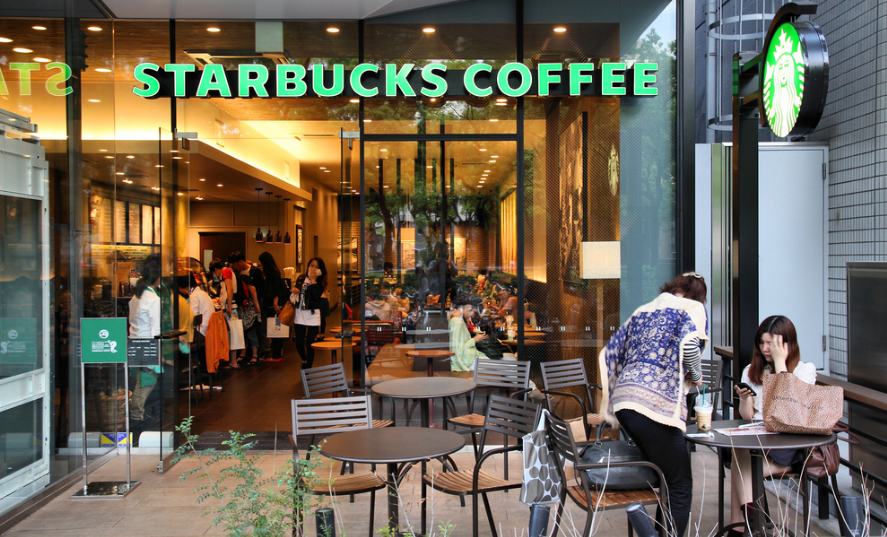CATTI 3 级英语笔译实务辅导教材解析 – CONVERTING THE MASSES: STARBUCKS IN CHINA

在 CATTI 英语笔译实务 3 级“活龙精益培训”冬季周末班(第一期)的公开课上(音频下载),我给学员讲解了全国翻译专业资格(水平)考试辅导丛书《英语笔译实务 3 级教材配套训练》第 55 页上的英译中练习。教材原文选自 2003 年 7 月 17 日《远东经济评论》(Far Eastern Economic Review)记者 Geoffrey A. Fowler 写的一篇报道《Converting the Masses: Starbucks in China》,但教材编者在改编时不恰当地删减了部分内容,导致前后文义不大衔接,甚至有几处删改后不成句。原始报道附在本文最末,可资参考。
在学习和做翻译时,我们要注意的几个问题
第一,认真、注重细节的态度是尽自己所能做好翻译的前提。比如,教材的编者为我们树立了反面的典型:他们在改编原文的材料时,未加仔细校对、审读,删改之后导致两处不成句子。以这样的工作态度来翻译,原本能做好的部分可能也会做砸。而且,这样的工作态度绝不会是一朝一夕形成的,它体现出来的是编者平时的学习不够认真、不够注重细节,教材整篇译文也表明了这一点。我们每个语言学习者和翻译工作者都要引以为戒。
第二,翻译时的一个原则是尽量不要改动原文的意思,这既是为了确保翻译后“意思不走样”(确保准确性),也是为了提高翻译工作的效率——用考虑如何改编原文的时间去翻译更多地内容(考虑经济性)。这更是为了避免给自己的翻译工作凭空、无谓地增加“难度系数”,因为随意改动原文的一个后果是很可能会“给自己挖坑”,译文横生枝节就会扭曲甚至歪曲原文的意思。当然,如果原文确实存在问题或者因为各种原因译文确实需要调整,那就需要根据情况处理了,但这需要的是丰富的翻译实践经验。
第三,在翻译时,题目、大小标题、正文,不同的地方需要不同的处理办法。这是翻译时必须弄清的一个方向性问题,也就是“你自己得知道自己是干嘛的”。比如,正文中只需要把事情说清楚时说清楚即可,不必“用力过猛”,但需要起到抓眼球作用的标题,需要着重处理的重点、要点、难点一定不要“关键时刻掉链子”,都力争处理好。需要译者来“表现”的时候,一定要“当仁不让”,在传达原文含义且译文恰当、“应景”的前提下可以“剑走偏锋”,稍加发挥,但要时刻记住自己的总体目的是让译文实现它的“设计用途”,也就是实现“原文的设计用途”。
第四,做英译汉翻译时,首先要看懂原文(做到很难,做不到“读懂原文”翻译时就会为了自圆其说而胡言乱语),看懂了之后用汉语把意思写清楚(做到非常难,很多译者的毛病汉语笔头功夫不够,有话说不清楚),而且不要有错别字或者语病(需要极为细心)。
最后,正如我在《我发现的两条定律——“蟑螂定律”和“英文必有错定律”》里面已经说的那样,“毛泽东思想”与“毛泽东的想法”不是一回事,“毛泽东思想”也适用于毛泽东本人。道理是简单的,做到是很难的。与君共勉。
辅导教材详细解析
I. CATTI 3 原文:Converting the Masses: Starbucks in China
CATTI 3 译文:星巴克强力吸引中国消费者
CGH 译文:星巴克“传道”中国
CGH 解析:
- 本句是教材中引用时的标题,也是原始文章的标题。
- convert 的原意是“改变人的想法”或者“让人接受一种新的信仰”,这里的意思是“让中国大众接受咖啡这种外来的饮品”,用加引号的“传道”一词可以强调让习惯喝茶的中国人尝试新饮品的难度,这既符合正文的文意思,作为标题又更能抓住读者的眼球。
II. CATTI 3 原文:It sounds like Mission Impossible: Sell coffee to China’s tea drinkers. Starbucks’ solution is to select high-profile locations on the busiest streets, where stores are sure to seduce the see-and-be-seen set.
CATTI 3 译文:向中国的饮茶人兜售咖啡,听起来像是不可能完成的任务(天方夜谭)。而星巴克的招数是选择繁华街道的黄金地段(醒目地点),在那儿咖啡店一定会吸引那些爱凑热闹的人。
CGH 译文:向中国的饮茶人兜售咖啡,这听起来像是天方夜谭。星巴克的招数是将店址选在繁华街道的醒目地点,这里的店铺一定会吸引那些好奇又张扬的人群。
CGH 解析:
- 本段原始报道中没有,应该是教材作者自行改编的。
- high-profile 是“高调”的意思,因此“醒目地点”更贴合原意。
- stores 这里是复数,意为泛指。根据文意,它应该是指在繁华街道醒目地点开设的所有店铺,而非仅仅星巴克一家。
- the see-and-be-seen set 是指那些喜欢看(see)新鲜事物(星巴克咖啡店等等),又喜欢被人看见(seen)身处这种环境、以显示自己身份的人士,“爱凑热闹”一词不足以表达全部含义。因此,酌情修改为“好奇又张扬的人群”。
III. CATTI 3 原文:As Starbucks launches an aggressive expansion in China, a coffee frontier steeped in nearly 5,000 years of tea. The goal: to build hip hang-outs that tap into a new taste for China’s emerging middle class.
CATTI 3 原文修改:As Starbucks launches an aggressive expansion in China, a coffee frontier steeped in nearly 5,000 years of tea, its location-scouting skills and marketing savvy will be put to the test. The goal: to build hip hang-outs that tap into a new taste for China’s emerging middle class.
CATTI 3 译文:随着星巴克在中国开拓市场的强劲势头,具有近五千年历史的中国茶文化就渗透了来自咖啡王国的浓香(咖啡先锋浸入拥有近五千年茶文化历史的中国)。目标是把星巴克建成时兴的常去的场所,吸引中国的新兴中产阶级品尝新的口味(开发新的口味来迎合中国新兴的中产阶级)。
CGH 译文:星巴克在中国开疆破土的势头颇猛,但中国是一个有着近五千年茶文化历史的国家,星巴克在这里寻址开店的技巧和市场营销面临着严峻的考验。星巴克的目标是把咖啡店建成时髦的热门去处,从而满足中国新兴中产阶级对咖啡这种新饮品的需求。
CGH 解析:
- 教材编者在删改之后,第一句变成了没有主句的分句,这里根据原始报道补全:its location-scouting skills and marketing savvy will be put to the test。
- “随着星巴克在中国开拓市场的强劲势头”不成话,改成“星巴克在中国开疆破土的势头颇猛”。
- 原文的“a coffee frontier steeped in nearly 5,000 years of tea”是前面China这个词的定语,是说中国有 5000 年的茶文化历史,它现在是星巴克咖啡在全世界“开疆破土”的一个新领域,但教材的译文改动了原文,其实大可不必,完全可以根据原文的意思写。
- tap into 的意思是“开发、利用”,意思就是利用中国消费者的新口味来赚钱。
IV. CATTI 3 原文:Starbucks China doesn’t plan any advertising, promotions, or other marketing strategies, aside from sponsoring an on-line coffee club and the occasional office-tower coffee tasting. Instead, the company is counting on selecting such high-visibility, high-traffic cafe locations that they market themselves. Its main advertising medium is the store itself.
CATTI 3 原文修改:… Instead, the company is counting on selecting such high-visibility, high-traffic cafe locations that market themselves. …
CATTI 3 译文:除了在网上主办咖啡俱乐部及偶尔在写字楼提供咖啡品尝活动之外,星巴克在中国不打算进行任何广告宣传、促销活动,也不打算实施其他的营销策略。相反,星巴克公司依靠选择那种显眼的、交通发达的咖啡店店址来做自我宣传;星巴克最主要的宣传媒介是咖啡店本身(相反,星巴克公司依靠的是咖啡店的选址,交通便利的醒目地址便是其最主要的宣传手段)。
CGH 译文:除了在赞助一家网上咖啡俱乐部以及偶尔在写字楼提供咖啡品尝活动之外,星巴克在中国不打算进行任何广告宣传、促销活动,也不打算实施其他的营销策略。相反,星巴克公司依靠的是咖啡店的选址,交通便利的醒目地址便是其最主要的宣传手段。
CGH 解析:
- 报道原文有一处错误:high-visibility, high-traffic cafe locations that they market themselves 中多了一个 they,需要删除才成句。
- sponsor an online coffee club 的意思是星巴克为这家咖啡俱乐部提供赞助,也就是商业赞助:出钱给俱乐部,俱乐部给星巴克做宣传。
- 教材中括号里面的译文要比括号外面的好很多,因此采用括号内的译文。
V. CATTI 3 原文:But in fast-changing Chinese cities, finding locations that will embody the right lifestyle is more akin to gambling than science. The computerized mapping databases that the company uses to test a potential street corner in the United States would be little help in Chinese cities. Yet Starbucks faces an uphill battle. Local media reported that 70% of people they surveyed would rather not see the chain in Beijing’s Forbidden City. And even for middle-class Chinese, Starbucks is a barely affordable luxury.
CATTI 3 原文修改:But in fast-changing Chinese cities, finding locations that will embody the right lifestyle is more akin to gambling than to science. Real-estate know-how is a hallmark of Starbucks worldwide, but the computerized mapping databases that the company uses to test a potential street corner in the United States would be little help in Chinese cities. Yet Starbucks faces an uphill battle. Local media reported that 70% of people they surveyed would rather not see the chain in Beijing’s Forbidden City. And even for middle-class Chinese, Starbucks is a barely affordable luxury.
CATTI 3 译文:然而,在变化莫测(变化飞快)的中国大城市找到能体现适当生活方式的地方,与其说是一种科学的经营理念,倒不如说是一场赌博(很像是一场赌博而不像是科学经营手段)。在美国,该公司利用计算机处理的地图数据库探寻潜在街角,但这种做法在中国城市却没有多大用处。同时,星巴克也面临着一场攻坚战。据当地媒体报道,70%的接受抽查者不同意星巴克在北京的紫禁城开连锁店。即使对中国的中产阶层而言,星巴克咖啡也是一种勉强能消费得起的奢侈品。
CGH 译文:然而,在飞速变化的中国城市找到能恰好体现星巴克所代表的生活方式的店址,与其说是一种科学,倒不如说是一场“赌博”。在全球市场,星巴克素以对房地产有独到的洞察力而著称,它利用计算机处理的映射数据库来研究在美国街头某一个位置开设星巴克咖啡店的盈利潜力,但这种做法在中国城市却没有多大用处。同时,星巴克也面临着一场攻坚战。据当地媒体报道,70% 的接受调查者不希望星巴克在北京的紫禁城开连锁店。即使对中国的中产阶层而言,星巴克咖啡也是一种很难消费得起的奢侈品。
CGH 解析:
- 报道原文 more akin to gambling than science 在 science 之前增加一个 to,即改成 more akin to gambling than to science,会更好一些。
- 补全教材删掉的原文,即 Real-estate know-how is a hallmark of Starbucks worldwide, but。
- fast-changing 是“飞速变化”或者“变化飞快”,其中没有“莫测”这个意思。
- Chinese cities 是“中国城市”,而非“中国大城市”,虽然中国标准的小城市在国外称得上是“大城市”。
- the right lifestyle 中的定冠词 the 指的是“与星巴克品牌相贴合”的生活方式。英语中的冠词是有含义的。
- more akin to gambling than to science 的意思是,在中国这种城市发展、变化很快的国家给星巴克选合适的店址靠的是运气,用科学的办法是找不到合适店址的。但这只是给店选址,不是“经营”,“经营”包括的范围更广,比如下文中提到的店面布局、设计、产品供应,这些就是“科学经营”手段了。
- mapping 是一个术语,它在数学中指“函数”或者“映射”,指两个数学集之间的对应关系。
- to test a potential street corner 这句的意思是“测试”一个街头店店址的盈利“潜力”(potential )如何,英文的措辞是“一个‘潜在’的街角”,这与汉语不同。翻译时必须要把原文的意思用地道的汉语表达清楚。
- would rather not 是“不喜欢”或者“不希望”,而不是“不同意”。
- barely affordable 中的 barely 表示否定,意思是“很难消费得起”,不是“勉强能消费得起”。从价格来说,根据原报道中的数据,2003 年的一“中杯”拿铁(medium latté)是 22 元人民币,这个价格现在也不算便宜,更何况是十四年前。
VI. CATTI 3 原文:While retailers say a top marketing weapon in urban China is to charge more for public consumption. That’s because Chinese customers have different priorities than their American yuppie counterparts. Guys 40 years old are not coffee drinkers, but if the environment is good and the coffee is not bad, they’ll come back. The store layout, artwork and food options make Starbucks more friendly to Chinese eyes, but coffee remains the core offering and people don’t go there for the coffee. They go there to present themselves as modern Chinese in a public setting.
CATTI 3 原文修改:Retailers say a top marketing weapon in urban China is to charge more for public consumption, where price can serve as an indicator of quality and sophistication. That’s because Chinese customers have different priorities than their American yuppie counterparts. Guys 40 years old are not coffee drinkers, but if the environment is good and the coffee is not bad, they’ll come back. Tweaks to the store layout, artwork and food options make Starbucks more friendly to Chinese eyes, but coffee remains the core offering and people don’t go there for the coffee. They go there to present themselves as modern Chinese in a public setting.
CATTI 3 译文:不过,零售商们却说,在中国城市营销的一个最强有力的武器就是对大众消费品制定高价格,原因是中国消费者的侧重点与美国的雅皮士们不同。40 岁的中国人几乎不喝咖啡,但如果环境优雅、咖啡味道又不差,他们还会成为回头客。虽然咖啡仍是星巴克咖啡店的主题,但店内的布局、艺术品的摆放以及可供选择的各色食品比咖啡本身更令中国人着迷,而且人们光顾星巴克并不为了喝咖啡,而是为了在公共场合有机会表明自己是时尚的中国人。(星巴克咖啡店的布置、艺术作品及食品供应上中国人的眼球,但咖啡还是主要供应品,而且人们光顾星巴克不是为了喝咖啡,而是在公共场合炫耀自己是新潮的中国人。)
CGH 译文:不过,零售企业却认为,价格在中国体现着质量与品位,在中国城市营销的一个最强有力的武器就是对大众消费品制定高价格。这是因为中国的“雅皮士”消费者看重的与美国的雅皮士不同。40岁的中国人不喝咖啡,但如果环境优雅、咖啡味道又不错,他们还会成为回头客。星巴克咖啡店的布置、艺术设计及食品调整之后更符合中国消费者的口味,但咖啡还是主要的供应品,而且他们光顾星巴克不是为了喝咖啡,而是为了在公共场合炫耀自己“跟上了潮流”。
CGH 解析:
- While retailers say a top marketing weapon in urban China is to charge more for public consumption. 这不是一个完整的句子,教材编者在改编时大概是想把它转成一个从句,但后来又忘了给它安排一个主句。根据报道的原文补全:Retailers say a top marketing weapon in urban China is to charge more for public consumption, where price can serve as an indicator of quality and sophistication.
- “侧重点”说得不清楚,原文的意思是中国的消费者“看重”的东西跟国外的人不同。这么说其实还是不大清楚,看重什么东西由经济因素决定。根据美国统计部门的数据,从 1990 年到 2015 年的 25 年间,美国家庭收入中位数只增加了不到 4000 美元。其中,从中国加入世贸组织的 2000 年到2015年的 15 年间,美国家庭收入中位数下降了 645 美元。
- are not coffee drinkers 就是习惯上“不喝咖啡”,而不是“几乎不喝”。
- 教材的译文用“着迷”一个词完全“扭转”了原文的意思,堪称高超的“春秋笔法”。原报道中的 more friendly 只是说,中国消费者是不大喜欢星巴克的店面布局、装潢和售卖的食品的,但星巴克开到中国之后根据中国消费者的喜好对这些做了一些调整(tweaks),所以显得对中国消费者更加友好了(对比:user-friendly、translator-friendly。但即使有这些调整和店面布局,星巴克提供的主打产品还是:咖啡,只不过中国消费者去星巴克喝的不是咖啡,而是一种情调和感觉,即原文开头部分说的 see and be seen。
附录:《远东经济评论》原文及链接
Converting the Masses: Starbucks in China
By Geoffrey A. Fowler
Far Eastern Economic Review
July 17, 2003
Source link: https://www.globalpolicy.org/component/content/article/162/27615.html
How’s this for people-watching? On bustling Nanjing Lu, Shanghai’s main shopping strip, Kevin Lin and a posse of researchers monitor the passers-by outside a potential Starbucks store site with hand-held counting devices, tallying likely customers.
A trendy 20-something couple walk past. “They’re definitely a click,” says Lin. Next, an unlikely prospect–a woman in her 50s wearing comfortable slacks strolls by. “Actually, she’d get a click, too. She looked in the window of that boutique. We attract adventurous people,” says Lin, vice-president of the coffee-store chain’s Shanghai joint-venture partner, the Shanghai President Coffee Corp.
The researchers aren’t revealing how many clicks it takes to justify a Chinese Starbucks. That’s because the secret to United States-based Starbucks Coffee International’s plan to open hundreds of cafés in greater China isn’t in the coffee beans–it’s in the location.
As Starbucks launches an aggressive expansion in China, a coffee frontier steeped in nearly 5,000 years of tea, its location-scouting skills and marketing savvy will be put to the test. The goal: to build hip hangouts that tap into a new taste for China’s emerging middle class–to see and be seen, without breaking the bank.
That means people like Charles Lo. “I prefer the taste of tea,” says Lo, who drinks tea at home but coffee in public. Along with coffee at his local Starbucks café, Lo purchases something very much in demand in China these days, and something that Starbucks is expert in creating: an experience, a lifestyle. “It’s an attitude,” he says.
Though Starbucks is still hardly known in China, with 69 stores, it’s taking a big bet. The Seattle-based company announced last week that it would increase its stake in its Shanghai and Taiwan joint venture with President Coffee from 5% to 50%. Elsewhere, Starbucks opens stores in Guangzhou, its third mainland Chinese city, later this year, and aims to open hundreds more in the coming two years.
The China push may be the ultimate test of the brand’s lifestyle-oriented marketing approach. Starbucks China doesn’t plan any advertising, promotions, or other marketing strategies, aside from sponsoring an on-line coffee club and the occasional office-tower coffee tasting. Instead, the company is counting on selecting such high-visibility, high-traffic café locations that they market themselves. “Our main advertising medium is the store itself,” says Lin.
But in fast-changing Chinese cities, finding locations that will embody the right lifestyle is more akin to gambling than science. Real-estate know-how is a hallmark of Starbucks worldwide, but the computerized mapping databases that the company uses to test a potential street corner in the United States would be little help in Chinese cities.
“In the U.S., if you see a mall, it will probably still be there in two years,” says Ernest Luk, vice-president of finance for Starbucks Coffee Asia-Pacific. “A year passes by in a Chinese location, and you almost won’t know your way around there anymore,” he says.
The ultimate decision to open a location is based on the mix of pavement-traffic analysis, location-based buzz and local real-estate savvy. A team of “hot-spot” seekers traces the paths that link where potential customers live, work and play, then takes photos and develops a list of ideal sites. According to P. J. Tan, director of asset development for Starbucks Coffee Asia-Pacific, a map on the wall of the Shanghai Starbucks office plots current and potential sites. Certain pins mark high-profile cafés that help build a customer base and broad recognition, providing a foundation for new cafés, marked with different pins. (The map is so secret, Starbucks won’t even let a reporter see it.)
Yet Starbucks faces an uphill battle. Walking the tightrope between hip and Western is difficult in China. After Starbucks opened a store in Beijing’s hallowed Forbidden City in December 2000, outraged local media reported that 70% of people they surveyed would rather not see the chain there.
And even for middle-class Chinese, Starbucks is a barely affordable luxury. At a price of 22 renminbi ($2.65), even a medium latté takes a bite out of the monthly disposable income of an average three-person Shanghainese household: about $143 in April 2003. Starbucks has no plans to cut prices, and says that, in a Shanghai survey, most of its customers said they were happy with the charges.
Retailers say a top marketing weapon in urban China is to charge more for public consumption, where price can serve as an indicator of quality and sophistication. That’s because Chinese customers have different priorities than their American yuppie counterparts. “Guys 40 years old are not coffee drinkers, but if the environment is good and the coffee is not bad, they’ll come back,” says Starbucks’ Lin. Tweaks to the furniture, store layout, artwork and food options make Starbucks more friendly to Chinese eyes, but coffee remains the core offering.
“The Starbucks proposition in China is huge. But people don’t go there for the coffee. They go there to present themselves as modern Chinese in a public setting,” says Tom Doctoroff, the North Asia managing director of ad firm J. Walter Thompson. By contrast, high-end underwear maker Victoria’s Secret would flop in China, Doctoroff says, because the high-priced underwear isn’t visible. “Chinese are proudly conspicuous consumers,” he says.
And since he’s pushing the “Starbucks experience,” not just coffee, Lin isn’t worried about competition from copycat cafés such as Taiwan-based Dante Coffee, Japan-based Manave Coffee and even McDonald’s McCafé. “It’s helpful to have more coffee out there, to make people aware of it. But because of our high quality and service, I believe that the high-end coffee drinkers will still come to us,” he says.
But creating a coffee habit is not guaranteed, says Doctoroff. “Keeping up with the Zhangs costs money and the vast majority of the ‘newly affluent’ don’t have a lot of cash on hand. So they are highly selective,” he says. “In the long run, are they tapping into what the Chinese really like to drink?”

